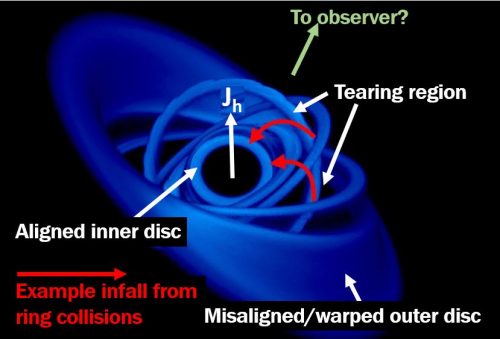A team of British astronomers has detected matter falling into a black hole at thirty percent of the speed of light. The black hole is in the center of PG211+143, a distant galaxy that spans one billion light-years. The astronomers used data from the XMM-Newton X-ray observatory to observe the black hole. The XMM-Newton, which the European Space Agency (ESA) launched in 1999, is the second cornerstone mission of ESA’s Horizon 2000 program.
Ken Pounds and colleagues wrote about their study and findings in Monthly Notices of the Royal Astronomical Society (citation below). Kenneth Pounds, CBE, FRS, is Emeritus Professor of physics at the University of Leicester.
A black hole has a strong gravitational field
A black hole is an object with an extremely powerful gravitational field. Not even light travels fast enough to escape a black hole’s grasp. Hence, the term black hole.
For astronomers, black holes are hugely important because they offer the most efficient way of extracting energy from matter. As a direct result, gas infall (accretion) into black holes must be powering the Universe’s most energetic phenomena.

Supermassive black hole in each galaxy
The center of every galaxy contains a supermassive black hole. Supermassive black holes have millions and even billions of times the mass of our Sun.
If enough matter falls into the hole, these can become extremely luminous. We see them as an active galactic nucleus (AGN) or a quasar.
Black holes are extremely compact. Therefore, gas is nearly always rotating too much to fall into them directly. Gas approaches the hole gradually through an accretion disk. An accretion disk is a sequence of orbits that get smaller and smaller. In other words, they ‘circle the drain’ in ever-decreasing circles.
The gas moves faster and faster and becomes luminous and hot as it spirals inwards. During this process, gravitational energy turns into the radiation that astronomers observe.
The rotation of the black hole
Scientists assume that the rotation of the black hole and the orbit of the gas are in alignment. However, there is no compelling reason for this to be true.
The reason we have winter and summer is that our planet’s daily rotation doesn’t line up with its yearly orbit around the Sun.
Until now, nobody has known how misaligned rotation may affect the infall of gas. As far as supermassive black holes are concerned, this is particularly relevant because matter can fall in from any direction. Interstellar gas clouds and isolated stars are examples of matter that can fall in.
Using XMM-Newton’s data, Prof. Pounds and colleagues looked at X-ray spectra from the distant galaxy PG211+143.
PG211+143 is over one billion light-years away in the direction of the constellation Coma Berenices. It is a Seyfert galaxy. In other words, it has a massive black hole at its nucleus Hence, its very bright AGN.
30% speed of light
The scientists found the spectra to be strongly red-shifted. It showed that the observed matter was falling into the black hole at 30% of the speed of light. The matter was traveling at 100,000 kilometers per second or 62,137 miles per second.
Regarding the gas, in a press release, the University of Leicester wrote:
“The gas has almost no rotation around the hole, and is detected extremely close to it in astronomical terms, at a distance of only 20 times the hole’s size (its event horizon, the boundary of the region where escape is not longer possible).”
Observations agree with previous study
The scientists say their observations agreed closely with recent theoretical work using the UK’s Dirac supercomputer facility. That theoretical work, which simulated the ‘tearing’ of misaligned accretion discs, also took place at Leicester University.
It showed that rinks of gas can break off and then collide with each other, which cancels out their rotation. Subsequently, the gas falls directly towards the black hole.
Prof. Pounds said:
“The galaxy we were observing with XMM-Newton has a 40 million solar mass black hole which is very bright and evidently well fed. Indeed some 15 years ago we detected a powerful wind indicating the hole was being over-fed. While such winds are now found in many active galaxies, PG1211+143 has now yielded another ‘first,’ with the detection of matter plunging directly into the hole itself.
“We were able to follow an Earth-sized clump of matter for about a day, as it was pulled towards the black hole, accelerating to a third of the velocity of light before being swallowed up by the hole.”
A rapidly-growing black hole
This study suggests that ‘chaotic accretion’ from misaligned disks is probably common for supermassive black holes. These black holes would then spin relatively slowly. They would gobble up gas at a faster rate and grow their masses faster than generally believed.
This might explain why the black holes that emerged in the early Universe gained so much mass so quickly.
In a separate study, scientists from Harvard University and the University of Texas found that black holes crush matter into nothing.
Citation
“An ultrafast inflow in the luminous Seyfert PG1211+143,” K A Pounds, C J Nixon, A Lobban, and A R King. Monthly Notices of the Royal Astronomical Society, Volume 481, Issue 2, 1 December 2018, Pages 1832–1838, https://doi.org/10.1093/mnras/sty2359.
Video – Matter falling into black hole
This Leicester University video is a computer simulation that predicts matter falling into a black hole at very high speed.

